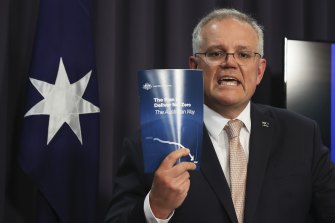Net zero sum game Morrisons tech-based plan emits hope but lacks detail
The federal government’s commitment to a target of net zero carbon emissions by 2050 is a major breakthrough in Australia’s climate war, and it should be warmly welcomed. The long-term emissions reduction plan announced on Tuesday is a solid update on the government’s commitment to developing low-cost, low-emission technologies. But it is not a policy platform to hit the emissions reduction target.
The Prime Minister, Scott Morrison, and the Minister for Industry, Energy, and Emissions Reduction, Angus Taylor, have been consistently clear that there would be no new policies or priorities â€" and they have stuck to that position.

Scott Morrison announced the government’s emission’s reduction policy on Tuesday.Credit:Alex Ellinghausen
The government also released its updated projections for Australia’s emissions through to 2030. They show that the target of a reduction of 26-28 per cent below the level in 2005 by 2030 will be exceeded, with an expected reduction of 30-35 per cent. The improvement at the bottom of this range is due to further reductions in emissions from electricity generation, almost entirely driven by state-based policies.
The first difficulty with the Prime Minister’s plan is that a continuation of the projected trend in greenhouse gases to 2050 will mean 195-290 million tonnes a year will still be emitted in 2050. The plan provides no detail that connects the projected technology developments with tackling that substantial 2050 shortfall. This detail may yet be published, but to depend on a rapid improvement in emissions reductions in the 2040s due to technological innovation is a highly questionable strategy.
There are two major concerns with the credibility of the plan. First, it seems to assume that all low-emission technologies can be brought to a point of cost parity with their current high-emission equivalent. This is largely true of renewable energy today. However, getting to this point was not a cost-free journey, and all Australians are still paying for it through their electricity bills. It was also a mandate imposed on electricity retailers, and the government is determined to avoid such policies in future.
Adding carbon capture and storage to a supply chain to remove emissions, or green hydrogen to provide zero-emission energy or chemical feedstock, will both add cost, even if the government’s target for the latter of $2 per kilogram is achieved. There will need to be some form of policy to deploy these technologies: either payment by governments, regulation, or market-based obligation.
The second concern arises because there are many actions to reduce emissions that will not depend on technologies. In the coming years, tens of thousands of small businesses and a couple of hundred big businesses will need to decide whether to switch from processes that produce emissions to those that do not â€" for example switching from gas to electricity for heat. Every one of these decisions will have a capital equipment replacement cost. If the businesses do not choose the low-emission alternative, then emissions will be locked in for many years, regardless of how cheap new technologies might be in the future.
Australian households adopted rooftop solar with enthusiasm, but that was largely due to generous subsidies paid for by their neighbours and their fellow taxpayers.
The idea that technologies will be cost-free and adopted by Australian households and businesses is dangerously close to magic pudding territory.
Two of the biggest sources of Australia’s emissions are associated with the mining and extraction of coal and liquefied natural gas, or LNG, for exports. There is no known way to capture the fugitive emissions from open-cut coal mining, and there are very significant technical challenges and costs that will need to be addressed if the answer is carbon capture and storage, or CCS. LNG and coal mining cannot be waved away with CCS. A similar question arises with the assumptions for delivering about 30 per cent reductions in agricultural emissions. The technologies around the vaccines and food additives that might reduce methane emissions from livestock are at very early stages of development and their costs and efficacy yet to be tested, let alone how they get delivered to thousands of head of free-range cattle.
The plan assumes that 10-20 per cent of the shift from 615 million tonnes of emissions in 2005 to zero in 2050 will be achieved by buying offsets from our regional neighbours or removing greenhouse gases from the atmosphere. This is possible, but it ignores the reality that many other countries will be seeking offsets, driving up the prices. Minister Taylor holds great confidence in this area, and he may yet be proven correct, but again, the activities are highly uncertain or very expensive at present.
There is no question that technology development must be a key pillar of any plan to achieve net zero by 2050. But it will not stand alone. The second pillar must be clear policies to drive the actions that we know today are effective in reducing emissions, and then deploy the ones that will emerge tomorrow as the technology efforts bear fruit. And the third will be to structure financial markets to deliver the investment upon which the transition will depend.
Tuesday’s technology-based plan is necessary, but it is not sufficient.
The Morning Edition newsletter is our guide to the day’s most important and interesting stories, analysis and insights. Sign up here.
Tony Wood is head of the energy program at the Grattan Institute.
0 Response to "Net zero sum game Morrisons tech-based plan emits hope but lacks detail"
Post a Comment